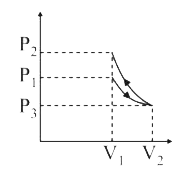An ideal gas is initially at P1,V1 is expands to P2,V2 and then compressed adiabatically to the same volume V1 and pressure P3. If W is the net work done by the gas in complete process which of the following is true.
A
W>O,P3>P1
B
W<0,P3>P1
C
W>0,P3<P1
D
W<,P3>P1
Video Solution
Text Solution
The correct Answer is:B
In the first process W is +v3 as ΔV is +ve , in the second process W is −ve as ΔV is −ve and area under the curve of second process is more. Therefore, the net work < 0 and also p3>P1.

|
Similar Questions
Knowledge Check
An ideal gas of volume V and pressure P expands isothermally to volume 16 V and then compressed adiabatically to volume V . The final pressure of gas is [γ=1.5]
APB3PC4PD6PAn ideal gas has initial volume V and pressure p. In doubling its volume the minimum work done will be in the process (of the given processes)
A(a) isobaric processB(b) isothermal processC(c) adiabatic processD(d) same in all given processesAn ideal gas expands isothermally from volume V1 to V2 and is then compressed to original volume V1 adiabatically. Initialy pressure is P1 and final pressure is P3. The total work done is W. Then
AP3>P1,W>0BP3<P1,W<0CP3>P1,W<0DP3=P1,W=0
A sample of gas expands from volume V1 to V2. The amount of work done by the gas is greatest when the expansion is
View SolutionAn ideal gas expands isothermally from volume V1 to V2 and is then compressed to original volume V1 adiabatically. Initialy pressure is P1 and final pressure is P3. The total work done is W. Then
View SolutionDiatomic gas at pressure 'P' and volume 'V' is compressed adiabatically to 1/32 times the original volume. Then the final pressure is
View SolutionA gas expands under constant pressure P from volume V1 toV2The work done by the gas is
View SolutionA monoatomic gas at pressure P1 and volume V1 is compressed adiabatically to 18th of its original volume. What is the final pressure of gas.
View Solution
